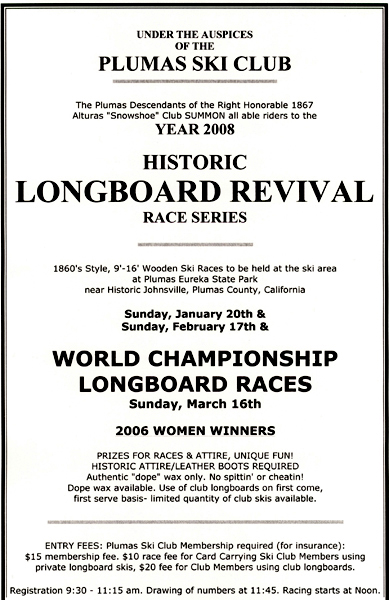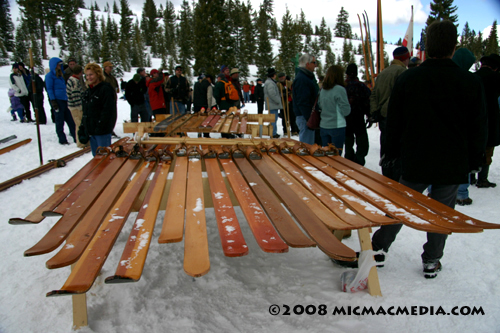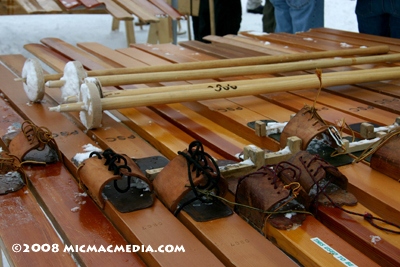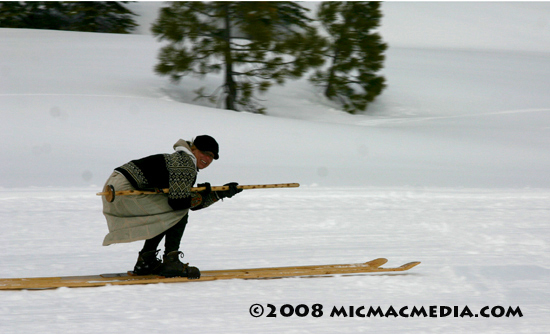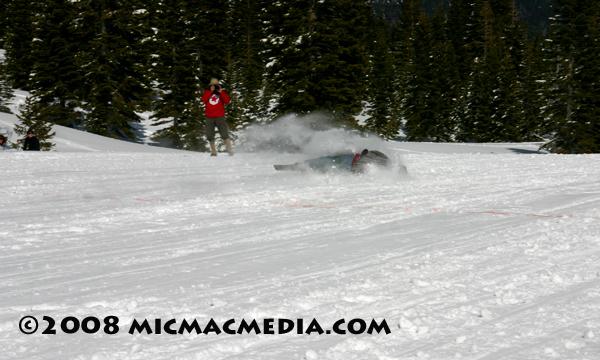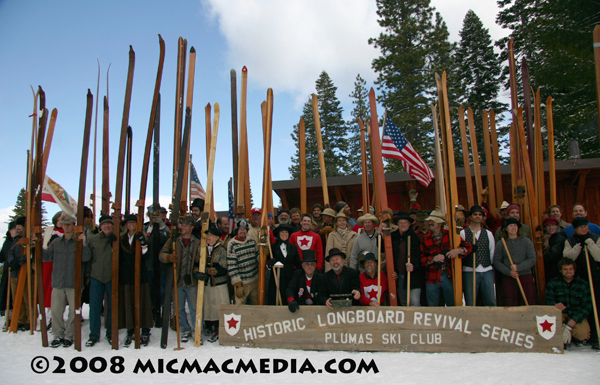 |
|
|
Follow Mark on Facebook for more stories |
||
 |
|||||
|
Tahoe Nugget #135: 2008 Longboard Ski Championships Yesterday, Sunday, March 16, the Plumas Ski Club hosted the 15th Annual World Championship Historic Longboard Revival Races at Plumas Eureka State Park. I realize that the event title is a mouthful, but they take their ski history seriously up in Plumas County. They claim that the first downhill ski races in the Western Hemisphere were held in Plumas County, and the historical record seems to uphold that boast. It was cold and blustery at the base of Eureka Peak following this weekend's winter storm, with about 8 inches of fresh powder topping the hefty snowpack. But that did not diminish the enthusiasm among the many racers and spectators in attendance. I was there for the 2006 races (the 2007 event was cancelled due to lack of snow) and the crowd yesterday was similar with more than 200 people ready for fun, food and music. The difference this year was the heavy turnout among the racers. There were about 17 women who signed up to compete on the heavy, 10 to 16-foot long skis and an incredible 38 guys ready to strut their stuff on the big boards. That's more than double the number of competitors that showed up for the 2006 championship race event! Tahoe Nugget #58 contains a short history of these race events and also includes six photos from the 2006 event, but I wanted to add a description of the equipment that I have excerpted from a handout printed and distributed at yesterday's races by the Plumas Ski Club: "The longboard skis were constructed of tight, vertical-grained Douglas fir. The skis were shaped with planes, the groove on the bottom with a special 'grooving' plane, and the tips bent by a long steaming process." There was no mention of weight, but I know that some pairs of these skis weigh more than 25 pounds. You can watch the contestants weaving with the weight as they carry the longboards up the ski slope to the starting line. "Bindings consisted only of two pieces of leather attached to the sides with three or four holes on each side for lacing tight. A small block of wood was attached to the ski to hold the heel in place. For starting and stopping, a six-foot long single stout pole with a block at one end was employed. Starting was accomplished by making three or four strong lunging thrusts, while stopping was matter of sitting on the pole to apply pressure, creating a drag and at the same time, a spectacular 'rooster tail' of snow." I saw three of these wooden braking poles snap in 2006, hence the nickname "soprano sticks." A strong start is key in a race of this type, but it's the wax or "dope" that is most important. Doping the boards involves applying concoctions of tree oils, pine pitch, turpentine, and even the brow of the sperm whale, as well as other ingredients to the ski bottoms. The recipes to these waxy substances were closely guarded secrets among 19th century dopemakers, a tradition that I'm sure continues today. Many of the top skiers at yesterday's races brought their own homemade longboards and used their best dope for the changing snow surface conditions. The winners of the 2008 Annual World Longboard Ski Championships this weekend were Allison Youngs, from nearby Quincy, California, who won the women's races. Phil Gallagher from Meadow Valley, Calif. took first place this year, after coming in second in 2006. The defending women's champion, Kina Nemeth, from Truckee, placed third this year. Tahoe Nuggets are now archived at www.thestormking.com Photo #1: Race Poster from this year's event.
|
|||||
|

